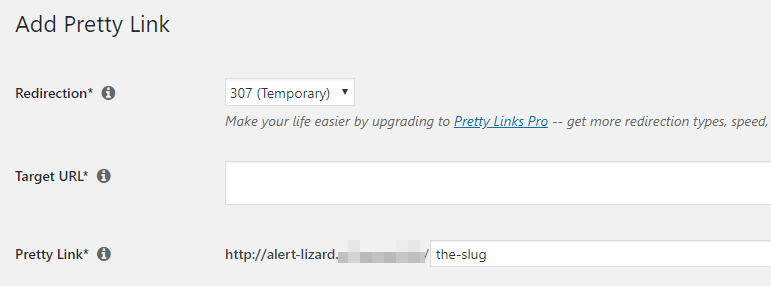3 weitere Link-Verkürzungs-Fehler (und wie Sie sie vermeiden können)

Inhalt
There are a lot of reasons you’d want to shorten your links. It makes them easier on the eyes, for example, and it can be great for marketing purposes. The problem is that there are some pitfalls you need to avoid when it comes to shortening links, especially if you want to get the most out of the process.
We’ve already talked about some of the Häufigste Fehler beim Verkürzen von Links wie z. B. die Verlinkung zu minderwertigen Inhalten und die falsche Verwendung von Ankertexten. Wir haben jedoch noch einiges zu tun, um Fehler zu vermeiden und eine bessere Linkstrategie zu entwickeln.
In this article, we’re going to briefly review why link shortening can benefit you. Then we’ll introduce you to three (more) link shortening mistakes you need to avoid, and talk about how to do that. Let’s jump right in!
Warum Link-Verkürzung eine wichtige Strategie ist
Linkkürzung ist ein Prozess, bei dem Sie einen langen, unordentlichen Link in etwas Kürzeres und Handhabbareres umwandeln. Stellen Sie sich zum Beispiel vor, dass einer Ihrer Blogbeiträge diese URL hat:
yourwebsite.com/blog/2018/05/02/postid=4534523
Dieser Link ist lang, unübersichtlich und sagt dem Leser nichts über den Inhalt, zu dem er führt. Mit einem Linkverkürzer können Sie diese URL durch etwas wie dieses ersetzen:
ihrewebsite.de/artikel-name
Wenn Sie Verwenden Sie ein professionelles Linkverkürzungsprogramm, you can use any text you want for your shortened links. However, link shortening is not just for cosmetic purposes. ‘Pretty’ links can also help to Ihre Klickraten zu verbessern and your affiliate marketing strategy. You can even use shortened links to reinforce your branding, so they’re a great addition to almost any website. That is, at least if you tackle link shortening the ‘right’ way.
3 (weitere) Fehler bei der Linkverkürzung, die Sie vermeiden müssen
If you haven’t read our previous piece on Häufige Fehler beim Verkürzen von Links, we’d suggest checking it out after you’re done with this one. That way, you’ll know everything you need to avoid when working on your links.
1. Keine Einbeziehung Ihrer Marke in Ihre Links
First up, let’s talk about branding. Ideally, all of your shortened URLs will include your site’s brand within them. Otherwise, you’re missing out on a key marketing opportunity, and visitors might even think that you’re using links from another site.
Außerdem wird durch die Verwendung Ihrer Marke für externe Links die Konsistenz Ihrer gesamten Website gewährleistet. Mit Pretty Links, your brand becomes part of each shortened link you create automatically. All you have to do is choose what comes after it, which is what we call the ‘slug’:

We’ll talk more about URL slugs shortly. For now, let’s move on to redirects.
2. Verwendung des falschen Umleitungstyps
One common misconception behind link shortening is that you’re transforming one URL into another. However, you aren’t actually erasing the original link. Instead, what you’re doing is creating a new link and pointing it towards the original one, using something called a redirect.
Wie Sie vielleicht wissen, gibt es verschiedene Arten von Weiterleitungen. Wenn es um die Verkürzung von Links geht, hängt es vom verwendeten Tool ab, zu welchen Arten Sie Zugang haben. Mit Pretty Links können Sie zum Beispiel Folgendes verwenden acht Arten von Weiterleitungen.
However, in most cases, you’ll want to stick with one of two options, which are:
- 301-Weiterleitung. This is what’s called a ‘permanent’ redirect, since it tells search engines to pass on the ‘link juice’ from one URL to another. You should only use this redirect if you’re sure the target URL won’t change later on.
- 307 Umleitung. This is known as a ‘temporary’ redirect, and is always safe to use. It doesn’t pass on any link juice, since the target URL might change.
Generally speaking, you’ll want to use 307 redirects for external links, since those might change at some point and are outside of your control. 301 redirects, on the other hand, are perfect for internal shortened links.
Um diese Aufgabe zu vereinfachen, können Sie mit Pretty Links bei jeder Verkürzung einer neuen URL den Typ der Weiterleitung aus einer Liste auswählen:

Überprüfen Sie einfach, in welche Kategorie Ihre Ziel-URL fällt, und wählen Sie eine Weiterleitung auf der Grundlage ihrer Merkmale.
3. Einstellung allgemeiner Slugs
Last but not least, it’s time to talk about slugs. A slug is the section of a URL that identifies a particular page. For example, in the URL yourwebsite.com/page-oneist der Slug "page-one":

Wenn Sie einen Link mit den richtigen Tools kürzen, können Sie einen Slug für die erzeugte URL wählen. Dies ist eine ideale Gelegenheit, einen Namen festzulegen, der eine Vorschau auf den Inhalt der Zielseite bietet und für die Besucher gut aussieht.
However, what a lot of people do is use overly generic slugs. Imagine, for example, that you’ve written a comparison article on the best running shoes you can buy. Here are two shortened link options you might use:
- ihrewebsite.de/schuhe
- yourwebsite.com/beste-laufschuhe-2018
The second option is superior. Although it’s longer, it tells visitors exactly what to expect. Plus, it even includes a ‘timestamp’, so people can see that the content is fresh (encouraging them to click on it). No matter what the content is about, what’s important is to focus on coming up with a slug that’s descriptive, yet not too long.
Schlussfolgerung
Viele Leute verwenden Linkverkürzer, ohne sich viele Gedanken zu machen wie they’re using them. Shortened links can benefit your website in a lot of ways, from reinforcing your brand to gathering better data about your affiliate linking strategy. However, if you don’t implement link shortening carefully, you won’t see the results you’re hoping for.
We’ve already talked about some of the Fehler beim Verkürzen von Links die Sie vermeiden müssen. Im Folgenden finden Sie drei weitere Techniken, die Sie beachten sollten, um sicherzustellen, dass Sie Ihre Linking-Strategie richtig anwenden:
- Binden Sie Ihre Marke in Ihre Links ein.
- Verwenden Sie für jede URL die richtige Art der Umleitung.
- Vermeiden Sie die Verwendung generischer Schnecken.
Haben Sie Fragen dazu, wie Sie Ihre Links richtig kürzen können? Fragen Sie uns im Kommentarbereich unten!